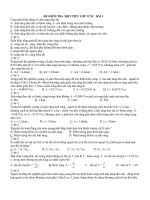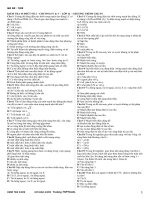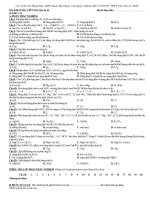WalMarts Financial Ratios Analysis
Bạn đang xem bản rút gọn của tài liệu. Xem và tải ngay bản đầy đủ của tài liệu tại đây (231.05 KB, 15 trang )
<span class='text_page_counter'>(1)</span>INTRODUCTION Wal-Mart was built to save people money so they can live better. Hints to their slogan: “Save Money. Live Better.” Their mission has allowed the company to grow around the world. The culture and the values of their employees help strive for success of Wal-Mart while serving over 200 million customers and members each week (Wal-Mart Annual). We strongly believe that Wal-Mart is the best- positioned global retailer and that they will continue to progress. Cost leadership is the advantage of Wal-Mart to enter the market. Doing our analysis of Wal-Mart Stores, Inc., we gathered our information and different figures from the Wal-Mart Annual Report and Financial websites. This paper may provide the insight to several financial aspects of the firm by analysis 13 financial ratios of Wal-Mart for 3 year (2009, 2010, 2011), and compare them with its competitor Cotsco and retail industry average.. CONTENT I. Overview about Wal-Mart and Costco: 1. Wal-Mart: “If we work together, we’ll lower the cost of living for everyone…we’ll give the world an opportunity to see what it’s like to save and have a better life.” Wal-Mart founder, Sam Walton, summarized his vision back in 1962 for a new type of discount store that consumers would appreciate. As an owner of a much smaller discount store Walton had the experience, did the research, and then put up 95 percent of the startup costs for his new company in which he and his wife truly believed in. The first store opened in Rogers, Arkansas and was incorporated as Wal-Mart Stores, Inc., on Oct. 31, 1969(Wal-Mart Corporate). The 1970’s and 1980‘s marked a period of rapid growth of the company. Wal-Mart had 38 stores in 5 states and 1,500 associates with sales of $44.2 million in less than a decade after opening. In the 70’s Wal-Mart had two 100 percent stock splits and expanded with the first distribution center being built in Bentonville, Arkansas. By the end of the 70’s Wal-Mart had became the first company to reach $1 billion in sales in such a short period of time by completing feats unheard of in that era. In 1983 Wal-Mart experienced a 100 percent stock split for the sixth time with a market price of $81.625; that same year a brand extension of the company was launched called Sam’s Club. Such success allowed them to purchase 16 Mohr-Value stores, Hutcheson Shoe Company, 92 Kuhn’s Big K stores, U.S. Woolco Stores, and many more. The expansion allowed for Wal-Mart to give variety to its name and add a full service auto center, pharmacy, 1-hr photo and jewelry store. Two more stock splits later and the company was in 29 states, with 1,198 stores, 200,000 employees and sales of $15.9 billion. From 1975 to 1983, Forbes magazine ranked Wal-Mart No. 1 among general retailers (Wal-Mart Corporate). The 1990’s saw Wal-Mart open international stores in Mexico City, Canada and expand into all 50 US states by 1995. Sam’s Choice brand items was introduced by Wal-Mart and sold successfully in Sam’s Clubs stores.. The company also had the ninth, tenth and eleventh 100 percent stock split allowing Wal-Mart to replace Woolworth on the Dow Jones Industrial Average. The 2000’s were marked with dozens of awards and achievements by Wal-Mart including recognitions of accomplishments in diversity, sustainability, patriotism, charity efforts, philanthropy and many more (Wal-Mart Corporate). Today, Wal-Mart still serves customers and members with the philosophy to “Save Money, Live Better”. Sales have reached an astonishing $405 billion with the help of more than 2 million employees here in the US and in 15 other countries. Currently there are more than 8,650 Wal-Mart retail units and the company is expanding every day (Wal-Mart Corporate). Compared to competitors in its industry, Wal-Mart has a business model that has made it dominant. Wal-Mart beat out their competitors, mainly smaller businesses by offering wider varieties of products at more competitive prices. This is a very simple business tactic, if you want to sell a lot of something cut your profit margin to beat the other competitors and you will sell more. It leads.
<span class='text_page_counter'>(2)</span> other firms in market capitalization by a wide margin. According to Yahoo! Finance, Wal-Mart leads its closest competitor, Target, by over 100 billion dollars in market capitalization due to its aggressive business model (Yahoo!). Statistics do show that Target is closing the gap on Wal-Mart. Recently Target prices were shown to be only four percent above Wal-Mart, compared to 14 percent above it two years before. Another major competitor, Kroger, has closed the gap with Wal-Mart, by finding efficient ways to lower their prices. Many other competitors in the industry are finding ways to do the same, but none have the power of Wal-Mart to cut out the middlemen and shift costs and risks onto the manufacturer (Forbes). Also according to Forbes other companies have failed to keep up with Wal-Mart because Wal-Mart has always been in the fore front of warehousing, distribution and trucking in-house. Compared with other firms in its industry Wal-Mart has kept the competitive advantage by also leading and setting standards with technology advances. It gathers retail information through high-tech barcode and product-tracking software, and revolutionized the relationship between merchant and vendor (Forbes).. 2. Costco: Costco Wholesale Corporation is now the strongest competitor of Wal-Mart. When newly formed, Costco was a small shops in Seattle in 1983, now has 457 stores, mostly concentrated in the U.S., in addition to Canada, England, Korea, Taiwan, Japan. Hower, now, being the Fifth National Retail Group, Costco is becoming a notable competitor of Walmart. To get the achievement, Costco has five tips when doing business: be interested in employees, keep low price, pay attention to customers and do not pay attention to competitors, do business with few sectors, create surprises to customers and employees. With these tips, Costco has created for themselves a solid position in the retail sector, created an attractive working environment and a reliable picture to customers.. II. Ratio Analysis: Part 1: Comparing the ratios of Wal-Mart in recent 3 years 1. Profit margin = 2011. 15,699 = 3.5 % 443,854. Net income Sales. 2010. 2009. 16,389 = 3.9 % 418,952. 14,335 = 3 .5 % 405,046. The profit margin calculates the amount in earnings a company actually keeps out of every dollar. Wal-Mart Stores Inc.'s net profit margin improved from 20109 to 2010 but then deteriorated significantly from 2010 to 2011. Net income 2. Return on assets (investment) = Total assets 2011. 15,699 = 8. 12 % 193,406. 2010. 2009. 16,389 = 9. 07 % 180,663. 14,335 = 8.4% 170,706. The return on assets ratio measures how efficiently management uses its assets to generate revenue. Wal-Mart Stores Inc.'s ROA improved from 2009 to 2010 but then deteriorated significantly from 2010 to 2011. Net income 3. Return on equity = Stockholders ' equity.
<span class='text_page_counter'>(3)</span> 2011. 15,699 = 22 . 01 % 71,315. 2010. 16,389 = 23. 91% 68,542. 2009. 14,335 = 20.26 % 70,749. The return on equity ratio measures the amount of profit a company generates with its shareholder’s investments, similar to its return on asset ratio. Wal-Mart Stores Inc.'s ROE improved from 2009 to 2010 but then slightly deteriorated from 2010 to 2011.. 4. Receivable turnover =. Sales(credit ) Receivables. 2011. 446 ,950 = 75. 28 5,937 times. 2010. 421 ,849 = 82.89 5 ,089 times. 2009. 408, 085 = 98.48 4,144 times. Receivable turnover: An activity ratio equal to revenue divided by receivables. Wal-Mart Stores Inc.’s receivables turnover deteriorated from 2009 to 2010 and from 2010 to 2011. Accounts receivable 4. Average collection period = Average daily credit sales. 5. 2011. 2010. 5,937 = 4.8 days (446 ,950 / 360 ). 5,089 = 4.3 days (421,849 / 360 ). 2009. 4,144 = 3.7 days (408,085/ 360 ). An activity ratio equal to the number of days in the period divided by receivables turnover. Wal-Mart Stores Inc.’s average receivable collection period increased from 2009 to 2011.. 6. Inventory turnover =. Sales Inventory. 2011. 443,854 = 10 .9 times 40,714. 2010. 418,952 = 11.5 36,318 times. 2009. 405,046 = 12. 2 33,160 times. An activity ratio calculated as revenue divided by inventory. Wal-Mart Stores Inc.’s inventory turnover deteriorated from 2009 to 2010 and from 2010 to 2011. Sales. 7. Fixed asset turnovers = ¿ Assets 2011. 443,854 =4 .05 109 ,603 times. 2010. 418,952 =3 .97 105 ,098 times. 2009. 405,046 =4 .07 99 ,544 times.
<span class='text_page_counter'>(4)</span> The ratio measures a company’s ability to generate sales from fixed assets. This ratio deteriorated from 2009 to 2010 (4.07 versus 3.97). In 2011, the ratio re-increases to 4.05 but it still slightly lower than its in 2009 (4.05 versus 4.07) The firm is in good operation. This increase may be a result of a large purchase made by Wal-Mart managers towards plant, property, or equipment. Sales 8. Total asset turnovers = Total Assets 2011. 443 , 854 =2 .29 193 , 406 times. 2010. 418 ,952 =2. 31 180 ,663 times. 2009. 405 ,046 =2 .37 170 ,706 times. The ratio decreases slightly from 2009 to 2010 and 2011. The higher in ratio, the better in using $1 of total assets to get profit. Wall-Mart operates their fixed assets effectively. The ratio of fixed assets turn over increases annually, but not so well on their current asset leading an effect on ratio of total asset turnover and a decrease from 2009 to 2011 though it’s not seriously. Current Assets 9. Current ratio = Current Liabilities 2011. 54 ,975 =0.88 62 ,300 times. 2010. 51,893 =0.89 58, 484 times. 2009. 48,331 =0,86 55,561 times. The ratio increases from 2009 to 2011 and decreases slightly in 2011. The current ratio measures ability in dealing with liabilities which is better year by year from 2009 to 2011. Wal-Mart’s current ratio is greater than previous years and thus it is clear the company has enough current assets to cover its current liabilities. Total quick Assets 10. Quick ratio = Current Liabilities 2011 Selected Financial Data (USD $ in millions) Cash and cash equivalents 6,550 Receivables, net 5,937 Total quick assets 12,487 Current liabilities 62,300 2011 2010. 12, 487 =0.2 times 62,300. . 12,484 =0 . 21 times 58,484. 2010. 2009. 7,395 5,089 12,484 58,484. 7,907 4,144 12,051 55,561 2009. 12,051 =0 . 22 times 55,561. Quick ratio measures the “instant” debt-paying ability of a company. Quick assets include those current assets that presumably can be quickly converted to cash. A company with a Quick Ratio of less than 1 cannot currently pay back its current liabilities. The higher the ratio, the stronger is the cash-paying ability of the firm. However, Wal-Mart Stores Inc.'s quick ratio deteriorated from 2009 (0.22 times) to 2010 (0.21 times) and from 2010 (0.21 times) to 2011 (0.2 times). That means the ability to payment by cash is lower. Currently, the Quick Ratio is 0.20 which clearly shows a lack of ability to cover short-term cash needs. WMT with a Quick Ratio = 0.2 is less than 1 => cannot currently pay back its current liabilities. This would indicate deteriorating cash flow. The reason is that Cash and cash equivalents was on the decrease from 2009 ($ 7,907 millions) to 2010 ($ 7,395 millions) and 2011 ($ 6,550 millions); and Receivables was on the increase from 2009 ($ 4,144 millions) to 2011 ($ 5,937 millions). In addition, Current liabilities increased.
<span class='text_page_counter'>(5)</span> significantly in 3 years, from 2009 ($ 55,561 millions) to 2010 ($ 58,484 millions) and 2011 ($ 62,300 millions). Therefore, Wal-Mart Stores Inc.'s quick ratio deteriorated from 2009 to 2011. The ability to payment by cash is not good. Total Debts 11. Debt to total assets = Total Assets 2011. 117,241 =60. 6% 193,406. 2010. 109,008 = 60 .3% 180,663. 2009. 97,470 = 57 .1% 170,706. . Wal-Mart Stores Inc.’s Debt to total assets increased from 2009 (57.1%) to 2010 (60.3%) and to 2011 (60.6%). It’s slightly more debt. It’s not good. The leverage ratio (Debt to total assets) measures the amount of debt a company has in proportion to its assets; the higher the ratio the more volatile and a higher chance to apply for bankruptcy, the lower the ratio the more conservative and less volatile. Here we can conclude that in the last 3 years, Debt to total assets of WMT has increased and this ratio is greater than 50% suggesting that over half of WMT’s assets are borrowed. If this is in fact the case, Wal-Mart must decrease its debt to avoid higher interest on new loans if loans are in the company’s foreseeable future. However, total revenues is still improved in 3 years. That means Wal-Mart managed debts effectively and business activities are operated well.. 12. Times interest earned =. 2011. 26,558 = 11.44 times 2,322. Income before interests∧taxes Interests. 2010. 25,542 = 11.584 times 2,205. 2009. 23,950 = 11.598 times 2,065. Times interest earned indicates the number of times that income before interest and taxes covers the interest obligation. The higher the ratio, the stronger is the interest-paying ability of the firm. However, Wal-Mart Stores Inc.'s Times interest earned ratio deteriorated from 2009 to 2011. That means the interest-paying ability of WMT is lower, not good. The reason is that Income before interests and taxes increased in 3 year, from $ 23,950 millions (2009) to $ 26,558 millions (2011), and interest payments increased from $ 2,065 millions (2009) to $ 2,322 millions (2011). 13. Fixed charge coverage: Fixed charge coverage measures the firm’ s ability to meet all fixed obligations rather than interest payments alone, on the assumption that failure to meet any financial obligation will endanger the position of the firm. Income before ¿ Fixed charge coverage = ¿ charges∧taxes ¿ charge. Income before interest taxes Payments of capital lease. 2011 $ 26,558. 2010 $25,542. 2009 $23,950.
<span class='text_page_counter'>(6)</span> obligations (in Statement of Cash flow) Income before fixed charge and taxes Fixed charge = lease obligations + interest expenses. Fixed charge coverage. 355. 363. 346. $26,913. $25,095. $24,296. 355 + 2,322 = $ 2,677. 363 + 2,205 = $ 2,568. 10.1 times. 9.8 times. 346 + 2,065 = $ 2,411 10.1 times. The fixed charge coverage decreased from 2019 to 2010 and then increased from 2010 to 2011. Fixed charge coverage measures the firm’s ability to meet all fixed obligations rather than interest payments alone, on the assumption that failure to meet any financial obligation will endanger the position of the firm. Comparing to 2009 and 2010, fixed charge coverage in 2011 increased slightly because EBIT and net interest and payment of capital lease obligations of Wal-Mart in 2011 increases from 2009 to 2011. That means the firm’s ability to meet all fixed obligations in 2011 is well than 2009, 2010.. Part 2: Comparing the ratios of Wal-Mart and Costco in 2011 Wal-mart (WMT) 1. Profit margin. 1,462 = 1.68% 87,048. WMT is higher than Costco => good. 8.12%. 1,462 = 5 .5 % 26,761. WMT is higher than Costco => good. 1,462 = 12 . 18 % 12,002 88 , 915 = 92.1 times 965. WMT is higher than Costco => good. 22.01%. 4. Receivable turnover. 75.28 times. 5. Average collection period. 7. Fixed asset turnovers 8. Total asset turnovers 9. Current ratio. Conclusion. 3.5%. 2. Return on assets (investment) 3. Return on equity. 6. Inventory turnover. Costco. 4.8 days. 965 = 3.9 days (88,915/ 360 ). 10.9 times. 87,048 = 13.1 times 6,638. 4.05 times. 87 ,048 = 7 times 12 ,432. 2.29 times. 87 ,048 =3. 25 times 26 ,761. 0.88 times. 13 .706 =1 .14 times 12. 050. WMT is lower than Costco => not good WMT is higher than Costco => not good. Average collection debts speed of WMT is slower and less efficient than Costco. WMT is lower than Costco => not good. Inventory turnover of WMT is less efficient than Costco. WMT is lower than Costco => not good. WMT managed fixed asset is less efficient than Costco. WMT is lower than Costco => not good. WMT managed total assets is less efficient than Costco. WMT is lower than Costco => not good. WMT has.
<span class='text_page_counter'>(7)</span> 10. Quick ratio 0.2 times 11. Debt to total assets 12. Times interest earned. 60.6%. less the ability of liquidity than Costco. WMT is lower than Costco (13,706 - 6,638 ) => not good. WMT has = 0 . 59 times less the cash-paying ability 12,050 than Costco. WMT has more debts than 14,188 = 53% Costco.. 26,761. 11.44 times. 2,439 = 21 times 116. 10.7 times. No data of Costco. 13. Fixed charge coverage. WMT is lower than Costco => not good. WMT has less the ability of payment than Costco.. Explanation: 1. Profit margin: Profit margin of WMT is higher than Costco. That means WMT managed costs more effective than Costco, so the Consolidated net income attributable to WMT is larger than Costco. 2. Return on assets (investment) Return on assets of WMT is higher than Costco. That means WMT managed assets more effectively than Costco. 3. Return on equity Return on equity WMT is higher than Costco. That means WMT managed stockholders’ equity more effectively than Costco. 4. Receivable turnover: In general, Wal-Mart collects the receivables lower than does Costco. This is show by the receivables turnover of 75.28 times versus 92.1 times for the Costco. Therefore, the capital of Wal-Mart is kept longer than Costco and the collective department of WalMart does not work more efficiently than Costco. 5. The average collection period suggest how long, on average, customers’ account stay on books. Wal-Mart’s Average collection period of 4.8 days, which is 0.9 day slower than Costco (3.9 days). So the capital of Wal-Mart is appropriated longer than Costco. 6. Inventory turnover: Wal-Mart turns over its inventory 10.9 times per year as contrasted with Costco average of 13.1 times. This tell us that Wal-Mart generates less sales per dollar of inventory than average company in the industry, and we can assume the Wal-Mart uses less efficient inventory-ordering and cost control methods than Costco. 7. Fixed asset turnovers: The ratio of CostCo is in much higher than Wal Mart’s in 2011 (7 times versus 3,95 times) to Wal-Mart, the firm uses up $1 of fixed assets to earn $3,88 of sales. On the other hand, CostCo earns $7 for sales using only $1 of fixed assets Wal-Mart consume fixed assets less effectively than CostCo does. 8. Total asset turnovers. The ratio of Wal-Mart (2.29 times) is not so well compared to CostCo’s which is higher in 2011 (3.25 times). CostCo consume current asset more effectively than Wal – Mart. 9. Current ratio: The CostCo’s liquidity ratio fare well in comparison with the Wal-Mart. The firm can meet each maturing obligation as it comes due. 10. Quick ratio of WMT (0.2x) is lower than Quick ratio of Costco (0.59 x). That means the cash-paying ability of costco was stronger than WMT. Costco has ability to pay better than wall-mart, 1 USD debt is equal to 0.6 USD ensure the company.The reason is that Cash and cash equivalents of costco was much than WMT and the receivable was lower. Also, Cotsco has short-term investments. Especially, Costco has less current liabilities than WMT. In sum, Costco manage well current asset and current liabilities than WMT..
<span class='text_page_counter'>(8)</span> 11. Debt to total assets of WMT is higher than costco. The reason is that costco has lower debts than WMT. In sum, Costco manage well total asset and total liabilities than WMT. 12. Times interest earned of WMT is lower than costco. Costco has ability to payment better than wall-mart, 1 USD interest of loan is equal to 21 USD ensure the company, while wall-mart only has 11.44 USD. The higher the ratio of Costco, the stronger is the interest-paying ability of the firm. The time interest earned ratio calculates a company’s ability to pay interest. As an increase in time interest earned is observed from 2010 to 2011, Costco appears to be headed in the right direction as the company is generating more in regards to its interest liabilities year after year, therefore reducing its total debt risk.. Dupont analysis ( Wal-Mart and Costco in 2011) Introduce: the dupont analysis is an excellent method to determine the strength and the weakness of a firm. DuPont analysis tells us that ROE is affected by three things: - Operating efficiency, which is measured by profit margin. - Asset use efficiency, which is measured by total asset turnover. - Financial leverage, which is measured by the equity multiplier. Analyzing: The return on assets (ROA) ratio developed by DuPont for its own use is now used by many firms to evaluate how effectively assets are used. It measures the combined effects of profit margins and asset turnover. net income Profit margin = sales Asset turnover =. sales total assets. ROA = profit margin * asset turnover. Walmart. Costco. 3.5%. 1.68%. 2.3 times. 3.25 times. 8.1%. 5.5 %. According to the calculation above, in 2011 Wall-mart has a profit margin of 3.5% which means that for every dollar of sale, Wall-mart is generating 3.5 cents of profit. This figure is much higher than Costco which has 1.68% for its profit margin. However, Wall-mart turned over its assets 2.3 times a year versus a considerably higher 3.25 times for Costco company. In other words, Costco has used its asset more efficiently in generating the sale comparing to Wall-mart. Although asset turnover of Wall-mart is lower than Costco, profit margin of Wall-mart is higher than Costco. Therefore, ROA of Wall-mart (8.1%) is higher than Costco (5.5%). This tells us that though Wall-mart has not efficiently turned over its asset for a better sale, it generated much profit for Wall-mart. As we mentioned, the higher ROE is the result of 3 cases ( high ROA, high leverage, combination of which). Walmart Costco Financial leverage =. total debt s total assets. 60.6%. 53%. ROA 1−financial leverage ≈ 21 % ≈ 12 % Wall-mart has a higher debt to asset ratio (60.6% for Wall-mart versus 53% for Costco) allowed Wall-mart to purchase more assets to generate a greater sales which result in higher return on equity (21% for Wall-mart versus 12% for Costco). In case of Costco, although it is better than Wallmart in using its assets to generate revenues but it is unable to capitalize this advantage into higher ROE due to its lower financial leverage. That indicates Wall-mart used debt more efficiency than Costco. However, Wall-mart will have to face a higher risk because of its higher debt to asset ratio. Return on equity =.
<span class='text_page_counter'>(9)</span> . In sum, it is true that by analyzing Costco’s ratios it can be demonstrated that this company has a more efficiency administration, a better liquidity, solvency and asuperior administration of working capital, Wal-Mart utilizes in a better way the resources given by its shareholders. Additionally, Wal-Mart is acompany that has resisted in a better way the economic crisis in such a way that it increased its net income in the last year obtaining a better profitability indicatorsmeasured by ROA and ROE. Therefore, in spite of the best performance made by Costco, it is considered that Wal-Mart is a more profitable company and that it manages its resources better.. Part 3: Comparing the ratios of Wal-Mart and Industry Average in 2011. 1. Profit margin 2. Return on assets. 3. Return on equity 4. Receivable turnover 5. Average collection period. 6. Inventory turnover. 7. Fixed asset turnovers. Wal-mart (WMT). Industry Average. 3.5%. 2.44%. 8.12%. 6.46%. 22.01%. 16.81%. 75.28 times 4.8 days. Above average. WMT managed costs more effectively than Industry Average. Above average. WMT managed assets more effectively than Industry Average. Above average due to ratio 2 and used debts effectively.. No data of Industry Average No data of Industry Average. 10.9 times. 7.05 times. 4.05 times. No data of Industry Average. 8. Total asset turnovers. 2.29 times. 2.08 times. 9. Current ratio. 0.88 times. 1.18 times. 0.2 times. 0.48 times. 10. Quick ratio. Conclusion. Good. The inventory turnover ratio shows how many times a company’s inventory is sold and replaced over a period. A low turnover implies poor sales and excess inventory when a high ratio implies strong sales or ineffective buying. When comparing Wal-Mart to industry, we see that Wal-Mart is slightly higher inventories than the industry. The reason for the high inventory turnover rate is that Wal-Mart’s management has put great emphasis on ensuring that all stores are well-stocked at all times.. Good. The total asset turnover ratio measures the amount of sales of assets. Wal-Mart’s asset turnover is greater than the industry average suggesting that the amount of the company’s current assets is well balanced, allowing to sell its products much quicker than its competitions. Below average. The current ratio describes a company’s ability to meet short-term, or current, liabilities. Wal-Mart’s current ratio falls just short of the industry average (0,88 times versus 1,18 times). It may encounter slight disavantages such as higher interest rates on new loans or difficulty buying on credit. Below average. The quick ratio is a measure of a company’s ability to meet short-term liabilities. In comparison to the current ratio, the quick ratio is more conservative as it excludes current assets which cannot be turned.
<span class='text_page_counter'>(10)</span> 11. Debt to total assets 12. Times interest earned 13. Fixed charge coverage:. 60.6%. 60% (*). 11.44 times. No data of Industry Average. into cash quickly. Quick ratio of WMT is lower than industry average; suggesting that even by excluding inventory from the current asset category, WMT is not able to meet its shortterm liabilities better than its competitors. Slightly more debts. However, revenues has increased steadily over the year => WMT used debts effectively and the business activities is still operated well. For some firms a higher debt ratio might indicate risk, but for stable WMT, this is not the case.. No data of 10.7 times Industry Average. Source: industry average ratios: < (*) < III. Discussion: Wal-Mart is a common stop among many households because of its convenience to consumers; it is the largest retailer in the United States and is gaining ground internationally. The firm is divided into three segments: Wal-Mart U.S. (63% of revenue, 3,700 stores), international (24%, 4,100), and Sam's Club (12%, 600). Wal-Mart U.S. revenue consists primarily of grocery (49% of revenue), entertainment goods (13%), and hard lines (12%). The firm's various store formats are known around the world for providing a wide variety of consumer needs at low prices (). Wal-Mart has become a necessity in many homes and is added to a list of routine activities that isn't given a second thought. Sam Walton had many local successful businesses prior to opening the first Wal-Mart in 1962. Within a few years Wal-Mart became successful and expanded internationally (Wal-Mart Annual). Wal-Mart is looking at the future by focusing on three points: growth, leverage, and returns (Wal-Mart Annual). • Growth: Domestically, Wal-Mart is planning to expand into metropolitan areas; internationally, they are expanding by purchasing internationally brands. • Leverage: Wal-Mart is focusing on cutting their expenses at a rate that exceeds revenue growth so income will grow faster than revenues. • Returns: Wal-Mart is looking to attract more investors and have a better chance to improve their investments. After researching Wal-Mart and analyzing its ratios, it’s obvious that the WMT will have advantages and disavantages: Advantages: - Wal-Mart is the most famous and biggest in the retail store in the world. It is well known by the majority of the United States, and a common household stop. - Wal-Mart is a bargain; consumers get the best value for their money. - Wal-Mart is not only a national success but has expanded internationally with stores in South America, Europe, and Africa. Wal-Mart international is in15 countries outside of the United States. - Overall reputation of Wal-Mart is good with many awards and a stable business history. - Wal-Mart is a monster in the retail industry and it doesn't allow small businesses to flourish. - Wal-Mart is a bargain that provides for all types of consumers, but there are rival companies such as Target, which advertises high quality products. - From an environmental point of view Wal-Mart has continued to grow and use natural resources but does very little to fund them back to the Environment..
<span class='text_page_counter'>(11)</span> - Wal-Mart definitely has a cost advantage because of its ability to acquire products at a lower price than its competition, therefore allowing them to sell it to the consumer for a price that other firms cannot match. The reason Wal-Mart has a cost advantage over other firms is “it would take decades of successful expansion for any firm to match Wal-Mart's tremendous size and scale” (investopedia). Wal-Mart’s scale lets them control their purchasing from suppliers which makes them more effective. This allows Wal-Mart to create low prices which easily hurt and sometimes put competitors out of the market. Wal-Mart's huge market capitalization was a result of its cost controls and low price advantage over competing firms. According to Chris Gallant of Investopedia, “Competition cannot easily recreate the brand recognition, economies of scale and technical marvel that is Wal-Mart's distribution network.” This has allowed Wal-Mart to produce huge profits making it the envy of competing smaller businesses. Disadvantages + Risk There are several risks that make WMT’s business unstable. - The first risk is their litigation problems. Wal-Mart is facing several lawsuits. If Wal-Mart loses any of these lawsuits it would create a liability and impact their net profits. - Wal-Mart, because of their size, has been able to demand concessions from venders that are in part how they keep their prices low. There is a risk that this tactic could backfire on them. Vendors could become alienated and as new pipelines for their products become available, they could choose to stop doing business with Wal-Mart. If a large enough number of suppliers leave it could ultimately impact Wal-Mart’s sales. - Wal-Mart is at this time dependent on international expansion for their growth. International business is risky for any company. Whenever a company does business internationally there is always the risk of running afoul of international laws or politics. There is also the risk of misunderstandings do to cultural differences in the new markets. - Recently, Obsession with cutting costs of Wal-Mart takes place in countless different forms, typically measures to strictly control the welfare and salary workers. Clearly, cost management for labor is not a crazy idea. But in the long term to pay wages and benefits "stingy" for employees will not necessarily synonymous with cost minimization. that is disadvantage of WMT when competing with other companies.. Appendix: Table 1: WAL-MART STORES INC., INCOME STATEMENT IN 3-YEAR 2011, 2010, 2009 (USD $ in millions). Period End Date Period Length Sales (all on credit) Net sales Cost of sales Gross profit Membership and other income Operating, selling, general and administrative expenses Operating income Interest (debt and capital leases) Interest income. 2011 Jan 31, 2012. 2010 Jan 31, 2011. 2009 Jan 31, 2010. 12 months 446,950 443,854 (335,127) 108,727 3,096 (85,265). 12 months 421,849 418,952 (315,287) 103,665 2,897 (81,020). 12 months 408,085 405,046 (304,657) 100,389 3,168 (79,607). 26,558 (2,322) 162. 25,542 (2,205) 201. 23,950 (2,065) 181.
<span class='text_page_counter'>(12)</span> Interest, net Income from continuing operations before income taxes Provision for income taxes Income from continuing operations Income (loss) from discontinued operations, net of tax Consolidated net income Consolidated net income attributable to noncontrolling interest Consolidated net income attributable to Walmart. (2,160) 24,398. (2,004) 23,538. (1,884) 22,066. (7,944) 16,454 (67). (7,579) 15,959 1,034. (7,139) 14,927 (79). 16,387 (688). 16,993 (604). 14,848 (513). 15,699. 16,389. 14,335. Source: Wal-Mart Stores Inc., Annual Reports. Stock Analysis on Net (www.stock-analysis-on.net) < Table 2: WAL-MART STORES INC., BALANCE SHEET IN 3-YEAR 2011, 2010, 2009 (USD $ in millions) Assets Cash and cash equivalents Receivables, net Inventories Prepaid expenses and other Current assets of discontinued operations Current assets Property and equipment, net, excluding property under capital leases Property under capital leases, net Property and equipment, net Goodwill Other assets and deferred charges Non-current assets Total assets. 2011. 2010. 2009. 6,550 5,937 40,714 1,685 89 54,975 109,603. 7,395 5,089 36,318 2,960 131 51,893 105,098. 7,907 4,144 33,160 2,980 140 48,331 99,544. 2,721 112,324 20,651 5,456 138,431 193,406. 2,780 107,878 16,763 4,129 128,770 180,663. 2,763 102,307 16,126 3,942 122,375 170,706. 4,047 36,608 5,089 3,638 9,427 18,154 1,164. 1,031 33,557 5,895 3,447 9,359 18,701 157. 523 30,451 5,986 3,224 9,524 18,734 1,365. Liabilities and equity Short-term borrowings Accounts payable Accrued wages and benefits Self-insurance Other Accrued liabilities Accrued income taxes.
<span class='text_page_counter'>(13)</span> Long-term debt due within one year 1,975 4,655 4,050 Obligations under capital leases due within 326 336 346 one year Current liabilities of discontinued 26 47 92 operations Current liabilities 62,300 58,484 55,561 Long-term debt, excluding due within one 44,070 40,692 33,231 year Long-term obligations under capital leases 3,009 3,150 3,170 Deferred income taxes and other 7,862 6,682 5,508 Non-current liabilities 54,941 50,524 41,909 Total liabilities 117,241 109,008 97,470 Redeemable noncontrolling interest 404 408 307 Preferred stock ($0.10 par value; none – – – issued) Common stock ($0.10 par value) 342 352 378 Capital in excess of par value 3,692 3,577 3,803 Retained earnings 68,691 63,967 66,638 Accumulated other comprehensive income (1,410) 646 (70) (loss) Walmart shareholders’ equity 71,315 68,542 70,749 Noncontrolling interest 4,446 2,705 2,180 Total equity 75,761 71,247 72,929 Total liabilities and equity 193,406 180,663 170,706 Source: Wal-Mart Stores Inc., Annual Reports. Stock Analysis on Net (www.stock-analysis-on.net). Table 3: COSTCO WHOLESALE CORPORATION INCOME STATEMENTS For the Year ended August 28,2011 (dollars in millions) REVENUE Net sales Membership fees Total revenue OPERATING EXPENSES Merchandise costs Selling, general and administrative Preopening expenses Provision for impaired assets and closing costs, net Operating income OTHER INCOME (EXPENSE) Interest expense Interest income and other, net INCOME BEFORE INCOME TAXES Provision for income taxes Net income including noncontrolling interests Net income attributable to noncontrolling interests NET INCOME ATTRIBUTABLE TO COSTCO NET INCOME PER COMMON SHARE ATTRIBUTABLE TO. $ 87,048 1,867 88,915 77,739 8,682 46 9 2,439 (116) 60 2,383 841 1,542 (80) $ 1,462.
<span class='text_page_counter'>(14)</span> COSTCO: Basic Diluted Shares used in calculation (000’s) Basic Diluted Dividends per share. $ 3.35 $ 3.30 436,119 443,094 $ 0.89. Source: Costco Wholesale Annual Report 2011. < Table 4: COSTCO WHOLESALE CORPORATION BALANCE SHEETS For the Year ended August 28,2011 (dollars in millions) ASSETS CURRENT ASSETS Cash and cash equivalents Short-term investments Receivables, net Merchandise inventories Deferred income taxes and other current assets Total current assets PROPERTY AND EQUIPMENT Land Buildings and improvements Equipment and fixtures Construction in progress Less accumulated depreciation and amortization Net property and equipment . OTHER ASSETS TOTAL ASSETS LIABILITIES AND EQUITY CURRENT LIABILITIES Short-term borrowings Accounts payable Current portion of long-term debt Accrued salaries and benefits Accrued sales and other taxes. $ 4,009 1,604 965 6,638 490 13,706 3,819 10,278 4,002 269 18,368 (5,936) 12,432 623 $26,761 $0 6,544 900 1,758 335.
<span class='text_page_counter'>(15)</span> Other current liabilities Deferred membership fees Total current liabilities LONG-TERM DEBT, excluding current portion DEFERRED INCOME TAXES AND OTHER LIABILITIES Total liabilities COMMITMENTS AND CONTINGENCIES EQUITY Preferred stock $.005 par value; 100,000,000 shares authorized; no shares issued and outstanding Common stock $.005 par value; 900,000,000 shares authorized 434,266,000 and 433,510,000 shares issued and outstanding Additional paid-in capital Accumulated other comprehensive income Retained earnings Total Costco stockholders’ equity Noncontrolling interests Total equity TOTAL LIABILITIES AND EQUITY. 1,540 973 12,050 1,253 885 $14,188 0 2 4,516 373 7,111 12,002 571 12,573 $26,761. Source: Costco Wholesale Annual Report 2011. < References:. 1. Wal-mart Stores Inc, Annual Report 2011 < 11_Annual_Report.pdf> 2. Costco Wholesale Annual Report <2011 3. 4. www.stock-analysis-on.net 5. ticker=WMT:US 6. ticker=COST:US 7. 8. 9. 10. 11. 12.
<span class='text_page_counter'>(16)</span>


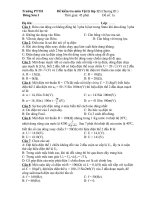
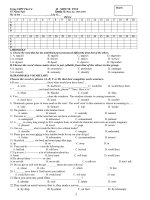

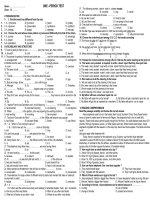
![bai 21 LS 12 (CB)[1]](https://media.store123doc.com/images/document/13/ly/sh/medium_shv1373362705.jpg)
